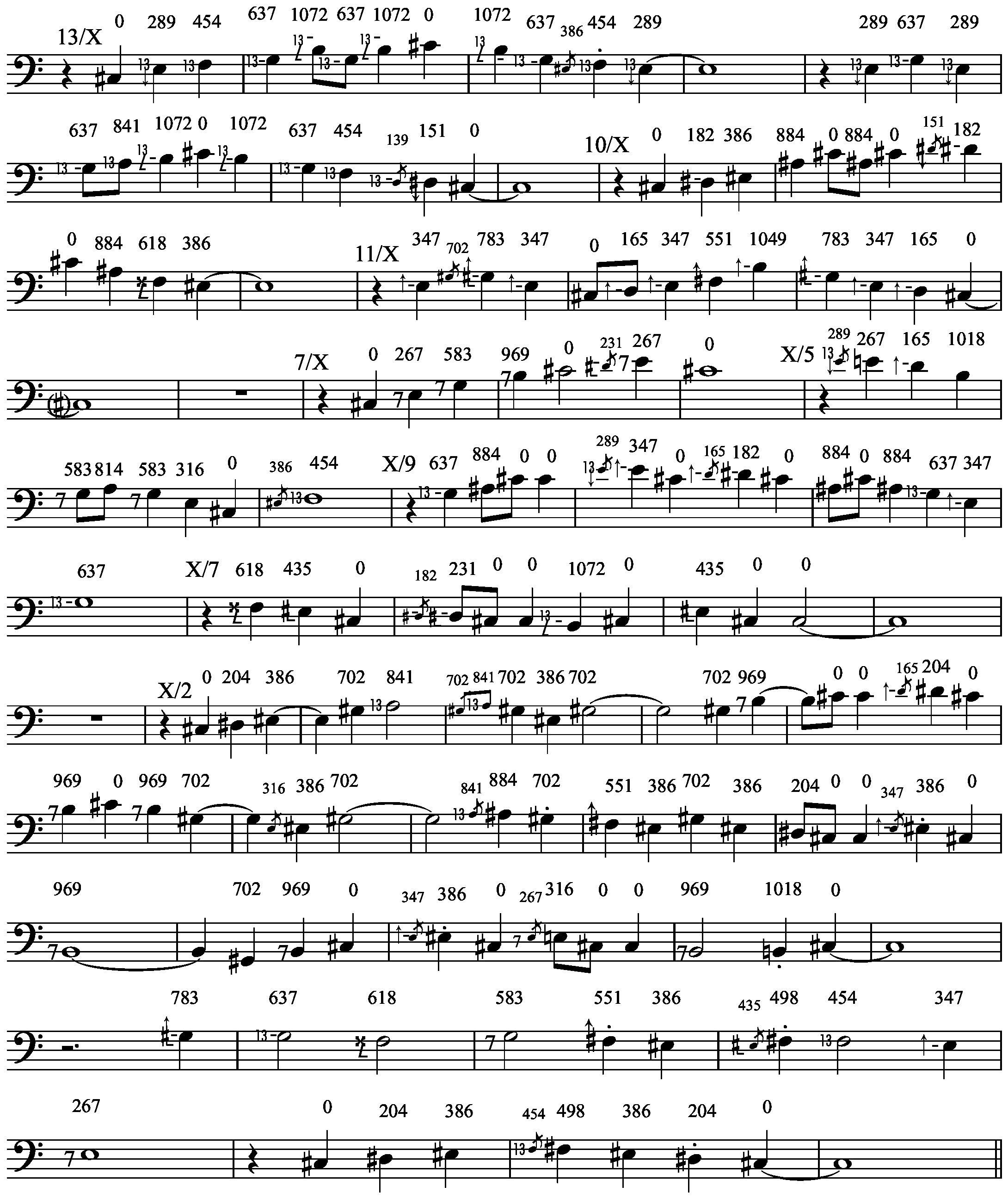I have always been fascinated by aardvarks. As a junior high kid I wrote a comic strip about a superhero called Super-Aardvark. His sidekick was a komodo dragon.
The idea I had for this piece was to write a simple, memorable melody conventional in every way except for its tuning, which would weave back and forth between familiar intervals and quarter- and sixth-tones. As in Ravel's Bolero, the melody repeats (four times) without alteration, with changes of only tone color and intensity. The plodding march time seemed appropriate for a procession of aardvarks. It is one of those comic pieces I write from time to time. The realization is electronic except for the chorus at the end, which I made by overdubbing my voice singing the melody, and the bass drum and tambourine, which I played in a studio. Here is the melody, with the number of cents above C# over each note, in Ben Johnston's notation (explained below). The melody starts at 0:14, 2:45, 5:16, and 7:47 in the recording if you want to follow it:
Another impetus was to reuse the wonderfully elegant tuning I had arrived at in my virtual piano piece Triskaidekaphonia, one whose possibilities I had only begun to explore. The tuning is superlatively simple: it consists of merely all the ratios formed by the whole numbers from 1 to 13, of which there are 29:
13/12, 13/11, 13/10, 13/9, 13/8, 13/7 (13/6, 13/5, and so on, are octaves of those already mentioned)
12/11, 12/7 (12/10 is the same as 6/5, 12/9 = 4/3, and so on)
11/10, 11/9, 11/8, 11/7, 11/6
10/9, 10/7 (10/8 = 5/4, 10/6 = 5/3)
9/8, 9/7, 9/5
8/7, 8/5
7/6, 7/5, 7/4
6/5
5/4, 5/3
4/3
3/2
1/1
The resulting scale (given in Ben Johnston's notation) is as follows:
Pitch: C# D13- D#v D^- D#- D# D#L- E7 E13v E E^- E# E#L F13 F# Ratio: 1/1 13/12 12/11 11/10 10/9 9/8 8/7 7/6 13/11 6/5 11/9 5/4 9/7 13/10 4/3 Cents: 0 138.6 150.6 165 182.4 203.9 231.2 266.9 289.2 315.6 347.4 386.3 435.1 454.2 498
F#^ G7 FxL G13- G# G#^L- A A13 A# A#L B7 B B^- B13L- 11/8 7/5 10/7 13/9 3/2 11/7 8/5 13/8 5/3 12/7 7/4 9/5 11/6 13/7 551.3 582.5 617.5 636.6 702 782.5 813.7 840.5 884.4 933.1 968.8 1017.6 1049.4 1071.7 (If you don't have enough experience with just intonation to make sense of this chart, try reading the step-by-step Just Intonation Explained section.) In Johnston's notation, + raises a pitch by 81/80, - lowers it by 80/81, # raises it by 25/24, b lowers it by 24/25, 7 lowers it by 35/36, L raises it by 36/35, ^ raises it by 33/32, v lowers it by 32/33, 13 raises it by 65/64, and F-A-C, C-E-G, and G-B-D are all perfectly tuned 4:5:6 major triads.
I had figured out in Triskaidekaphonia that I could make different scales within this network by taking all notes expressible by the form 13/X, or 11/X, or X/7, and the scales with the smallest numbers would be closest to simple tonality, while the larger-numbered scales will have a much more oblique relationship. Thus the scales that run through the piece are:
13/X: 1/1 13/12 13/11 13/10 13/9 13/8 13/7 12/X: 1/1 12/11 6/5 4/3 3/2 12/7 11/X: 1/1 11/10 11/9 11/8 11/7 11/6 10/X: 1/1 10/9 5/4 10/7 5/3 9/X: 1/1 9/8 9/7 3/2 9/5 8/X: 1/1 8/7 4/3 8/5 7/X: 1/1 7/6 7/5 7/4 X/9: 1/1 10/9 11/9 4/3 13/9 5/3 X/7: 1/1 8/7 9/7 10/7 11/7 12/7 13/7 X/5: 1/1 11/10 6/5 13/10 7/5 8/5 9/5 X/3: 1/1 13/12 7/6 4/3 3/2 5/3 11/6 X/2: 1/1 9/8 5/4 11/8 3/2 13/8 7/4 Of course, the scales with X in the numerator are overtone series, and those with X in the denominator are undertone series. (Harry Partch called them otonalities and utonalities.) Since all the pitches have a simple relationship to 1/1 C#, a rhythmicized drone on that pitch runs throughout. The piece, then, moves "in and out of focus" depending on which scale is used at a given moment.
Kyle Gann
Return to Just Intonation Explained
Return to List of Compositions


